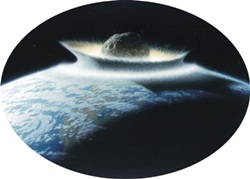
In fact, I believe we should stop worrying, and learn to see the meteorite in a wholly new and more benevolent light. Recent work by geologist Birger Schmitz (University of Lund, Sweden) has raised the possibility that meteorite impacts might be good for living things. In an amazing series of discoveries, he has found that about 470 million years ago the chances of being hit by a meteorite went up considerably.
About then, in an event akin to that which set the dino-killing impactor on its deadly course, a massive collision involving an asteroid about 185km in diameter, created the Flora family of asteroids and a wealth of space debris known to meteoriticists as the L-chondrites - which still comprise as much as 20% of all recorded meteorite hits today. However, when they first started arriving, barely a million years after the collision, they came in much greater numbers.
Schmitz and his co-workers have described fossil meteorites from limestones in southern Sweden. These limestones were laid down very slowly - and thanks to having been deposited in one of the Earth’s most geologically stable areas, they are still almost as fresh and flat as they were 470 million years ago, in the Ordovician Period. They comprise the greatest concentration of fossil meteorites ever described.
Because the area of the quarries in which they are found, the age of the rocks and the rate of sedimentation are all known, Schmitz has been able to calculate that during this time the Earth was being bombarded by twice more meteorite material than today. Even more intriguingly, this period of intense bombardment coincides exactly with one of the most sudden periods of evolutionary diversification in the history of life – the so-called Great Ordovician Biodiversity Event (GOBE).
Palaeontologists have puzzled about the GOBE for years, but although many theories have tried to explain why so many species and genera of marine life originated at this time, none seems able to explain its sheer suddenness. Schmitz now thinks he may have the answer. Perhaps intense but globally sub-lethal impacts by kilometre-sized impactors repeatedly sterilised areas of the Earth, allowing opportunistic species to move in and fill the ecological niches made vacant.
Such an ecological effect is a short step from the sort of diversity increases we see today when, for example, a gravel pit or quarry disturbs the natural order, increases the number of habitats available for living things, and so raises local biodiversity. In nature, the same thing happens without our help – for example, in shallow coral reefs, where storm waves do the work. Increased biodiversity in space translates into greater speciation through time.
It really is time to stop worrying and learn to love the meteorite. They are little threat to us, so long as we keep our eyes open. Only one mass extinction event, at the K/T Boundary, has ever been unequivocally linked to an extraterrestrial impact - and dating work in the Deccan of India is placing the maximum volume of volcanic outpouring there at just before the K/T impact - suggesting that the dinosaur extinction would probably have happened without it.
Although they have taken out a few animals (and at least one Chevy Malibu) no humans have ever been killed by meteorites. The famous Nakhla stone - a very rare lump of Mars, bounced to Earth by an impact that struck the red planet - is reputed to have killed a dog when it landed in Egypt in 1911 (which would be the only instance of an earthling dying at the hands of a martian). But even that’s probably a myth.
Meteorites are the oldest objects it is possible to hold in your hand. They deserve respect, but not out of fear.
* Dr Ted Nield is Editor of Geoscientist magazine and Geoscientist Online . His book Supercontinent – 10 billion years in the life of our planet” is published by Granta (UK) and Harvard University Press (USA); also by Kunstmann (Germany) and Paidos (Spain). He is currently working on a book about asteroids and meteorites, and humans’ attempts to derive meaning from them, called "Incoming".